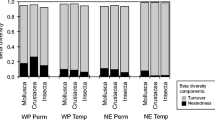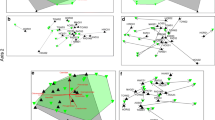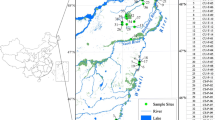Abstract
Macroinvertebrate communities sampled by a corer, plankton net and sweep net from five wetlands on the Swan Coastal Plain were compared. The composition of the fauna collected in sweeps and tows was generally similar and differed from that collected in the cores. Cores caught fewer species than tows and sweeps at all wetlands and did not capture fast swimming hemipterans or less abundant taxa. The highest species richness was recorded in sweep samples in four out of the five wetlands. Classification (TWIN-SPAN) and ordination (SSH) of the samples collected in sweeps and tows gave good separation of the wetlands, whereas classification of core samples did not. Coring appeared to be the least suitable sampling method for describing the major components of the macroinvertebrate communities of these wetlands. Plankton tows were useful if the time available for sorting was limited as these samples were free of sediments and generally gave similar results to those obtained with sweeps. Sweeps appeared to be the most useful method for a large classification study as they collected more species and resulted in the best discrimination amongst wetlands.
Similar content being viewed by others
References
Belbin, L., 1989. PATN Users Guide. CSIRO Division of Wildlife and Ecology, Canberra.
Boulton, A. J., 1985. A sampling device that quantitatively collects benthos in flowing or standing waters. Hydrobiologia 127: 31–39.
Clare, P. & R. W. Edwards, 1983. The macroinvertebrate fauna of the drainage channels of the Gwent Levels, South Wales. Freshwat. Biol. 13: 205–225.
Crisp, D. T., 1962. Estimates of the annual production of Corixa germani (Fieb) in an upland reservoir. Arch. Hydrobiol. 58: 210–223.
Davis, J. & S. W. Rolls, 1987. A baseline biological monitoring programme for the urban wetlands of the Swan Coastal Plain, Western Australia: seasonal variation in the macroinvertebrate fauna and water chemistry of five Perth lakes. Bulletin 265 Environmental Protection Authority (WA)/Water Authority of Western Australia, Perth.
Downing, J. A., 1984. Sampling the benthos of standing waters. In A manual on methods for the assessment of secondary productivity in fresh waters. Downing, J. A & F. H. Rigler (eds), Blackwell Scientific Publications, Oxford: 87–130.
Downing, J. A. & H. Cyr, 1985. Quantitative estimation of epiphytic invertebrate populations. Can. J. Fish. aquat. Sci. 42: 1570–1579.
Downing, J. A. & F. H. Rigler, 1984. A manual on methods for the assessment of secondary productivity in fresh water. Blackwell Scientific Publications, Oxford.
Friday, L. E., 1987. The diversity of macroinvertebrate and macrophyte communities in ponds. Freshwat. Biol. 18: 87–104.
Furse, M. T., D. Moss, J. F. Wright & P. D. Armitage, 1984. The influence of seasonal and taxonomic factors on the ordination and classification of running-water sites in Great Britain and on the prediction of their macroinvertebrate communities. Freshwat. Biol. 14: 257–280.
Gerking, S. D., 1957. A method of sampling the littoral macrofauna and its application. Ecology 38: 221–226.
Hellawell, J. M., 1986. Biological indicators of freshwater pollution and environmental management. Pollution Monitoring Series. Elsevier Applied Science Publishers, London and New York.
Hill, M. O., 1979. TWINSPAN — a Fortran Program for Arranging Multivariate Data in an Ordered Two-way Table by Classification of the Individuals and Attributes. Ecology and Systematics Section, Cornell University: Ithaca, New York.
Jensen, S., 1978. Influences of transformation of cover values on classification and ordination of lake vegetation. Vegetatio. 37: 19–31.
Johnson, R. K. & T. Wiederholm, 1989. Classification and ordination of profundal macroinvertebrate communities in nutrient poor, oligomesohumic lakes in relation to environmental data. Freshwat. Biol. 21: 375–386.
Kajak, Z., 1971. Benthos of standing water. In A manual on methods for the assessment of secondary production in fresh waters, G. G. Winberg (ed.) Blackwell Scientific Publications, Oxford: 25–65.
Kaminski, R. M. & H. R. Murkin, 1981. Evaluation of two devices for sampling nektonic invertebrates. J. Wildl. Mgmt. 45: 493–496.
Maarel, E. van der., 1979. Transformation of coverabundance values in phytosociology and its effects on community similarity. Vegetatio. 39: 97–114.
Macan, T. T., 1949. Survey of a moorland fishpond. J. anim. Ecol. 18: 160–186.
Marchant, R., 1990. Robustness of classification and ordination techniques applied to macroinvertebrate communities from the La Trobe River, Victoria. Aust. J. mar. Freshwat. Res. 41: 493–505.
McCauley, V. J. E., 1975. Two new quantitative samplers for aquatic phytomacrofauna. Hydrobiologia 47: 81–89.
Milbrink, G. & T. Wiederholm, 1973. Sampling efficiency of four types of mud samplers. Oikos 24: 479–482.
Minto, M. L., 1977. A sampling device for the invertebrate fauna of aquatic vegetation. Freshwat. Biol. 7: 425–430.
Murkin, H. R., P. G. Abbott & J. A. Kadlec, 1983. A comparison of activity traps and sweep nets for sampling nektonic invertebrates in wetlands. Freshwat. Invert. Biol. 2: 99–106.
Neckles, H. A., H. R. Murkin & J. A. Cooper, 1990. Influences of seasonal flooding on macroinvertebrate abundance in wetland habitats. Freshwat. Biol. 23: 311–322.
Ormerod, S. J. & R. W. Edwards, 1987. The ordination and classification of macroinvertebrate assemblages in the catchment of the River Wye in relation to environmental factors. Freshwat. Biol. 17: 533–546.
Paterson, C. G. & C. H. Fernando, 1971. A comparison of a sample corer and an Ekman grab for sampling shallowwater benthos. J. Fish. Res. Bd Can. 28: 365–368.
Quinn, J. M, & C. W. Hickey, 1990. Characterisation and classification of benthic invertebrate communities in 88 New Zealand rivers in relation to environmental factors. NZ. J. mar. Freshwat. Res. 24: 387–409.
Storey, A. W., S. E. Bunn, P. M. Davies & D. H. Edward, 1990. Classification of the macroinvertebrate fauna of two river systems in southwestern Australia in relation to physical and chemical parameters. Reg. Rivers Res. & Mgmt 5: 217–232.
Storey, A. W., D. H. Edward & P. Gazey, 1991. Surber and kick sampling; A comparison for the assessment of macroinvertrebrate community structure in streams of southwestern Australia. Hydrobiologia 211: 111–121.
Whiteside, M. C. & C. Lindegaard, 1980. Complementary procedures for sampling small benthic invertebrates. Oikos 35: 317–320.
Wright, J. F., D. Moss, P. D. Armitage & M. T. Furse, 1984. A preliminary classification of running-water sites in Great Britain based on macroinvertebrate species and the prediction of community type using environmental data. Freshwat. Biol. 14: 221–256.
Author information
Authors and Affiliations
Rights and permissions
About this article
Cite this article
Cheal, F., Davis, J.A., Growns, J.E. et al. The influence of sampling method on the classification of wetland macroinvertebrate communities. Hydrobiologia 257, 47–56 (1993). https://doi.org/10.1007/BF00013996
Received:
Revised:
Accepted:
Issue Date:
DOI: https://doi.org/10.1007/BF00013996




